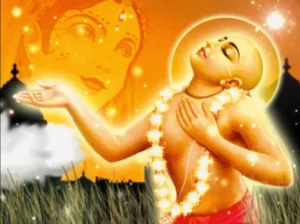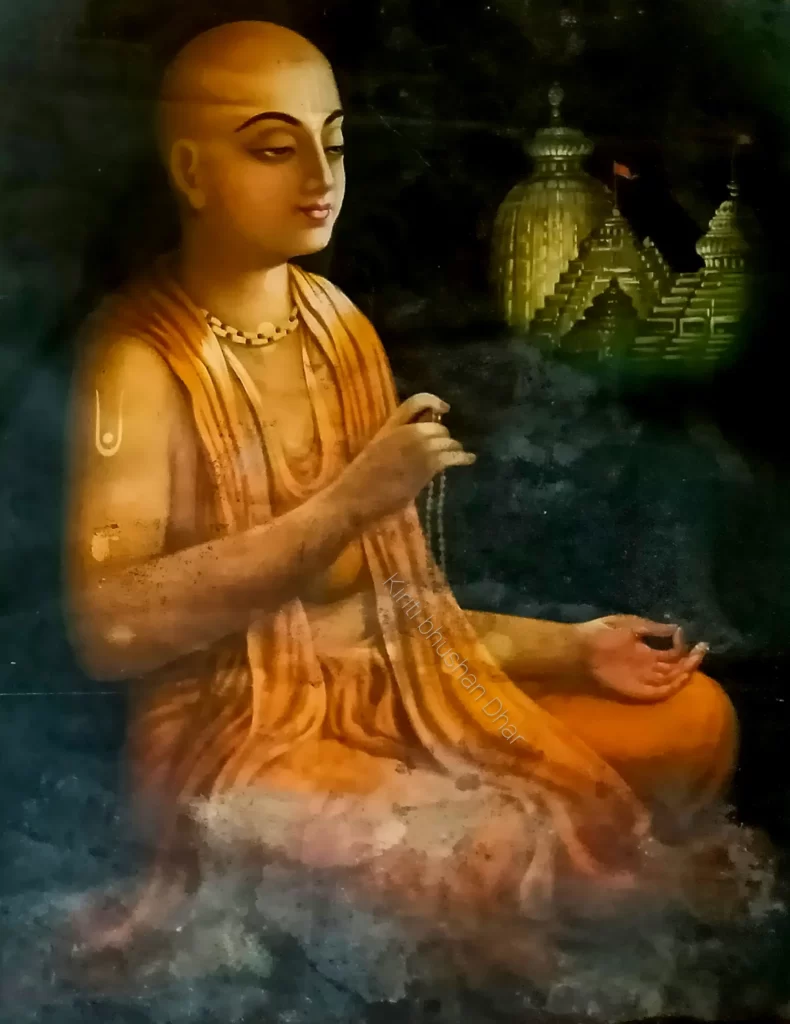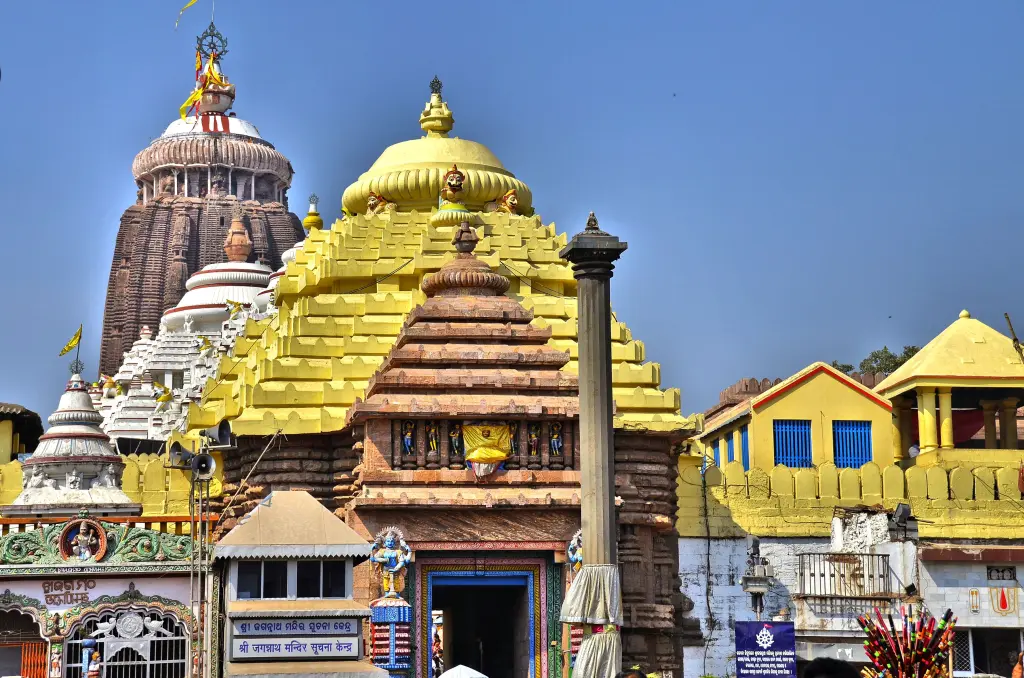 Chaitanya Mahaprabhu was a 15th-century Indian saint who rekindled devotion in his times. Chaitanya Mahaprabhu’s mode of worshipping Krishna with ecstatic song and dance had a profound effect on religious worship in Bengal.
Chaitanya Mahaprabhu was a 15th-century Indian saint who rekindled devotion in his times. Chaitanya Mahaprabhu’s mode of worshipping Krishna with ecstatic song and dance had a profound effect on religious worship in Bengal.
Chaitanya joined in one of the Patsalas (centres of Vedic learning). He showed extraordinary brilliance and precocity of intelligence in his studies, which amazed his teachers and the elders.
When Chaitanya was about seven years of age, his eldest brother Viswaroopa, who was just aged sixteen, choosing to become a sanyasin (a renunciate) left home. The parents felt very sad at this. The father, Jagannath Misra passed away two years after Viswaroopa left the home. The bereavement mellowed Nimai much, and his pranks and mischief came to an end. By the age of eighteen, Chaitanya completed his studies. He was no more the child Chaitanya, but a full-fledged and profound scholar, astonishing everybody with his depth of knowledge and wisdom and lucid enunciation and exposition of scriptural, metaphysical and spiritual truths. In discussions on any of these, his arguments stood always irrefutable and any disputant, however so learned he be, had to own defeat and acknowledge Nimai’s victory and supremacy.
Once a great and renowned scholar from Kashmir, by name Acharya Keshav, came to Chaitanya’s home town (Nadwip). He had the notion and conceit that no one was more knowledgeable than himself, and he would be able to vanquish any in argument. Nabdwip being famous as a centre of learning in those times, it was, so to say, the testing ground for proving one’s eminence in scholarship, by contesting scriptural debates at the gatherings and assemblies of pundits and winning in the debate and contest. Chaitanya had his tol (school) on the bank of the river Ganges. Pundit Keshav came along there and boastfully drew Chaitanya into discussion. Chaitanya suddenly requested the pundit to compose a hymn in Sanskrit on Mother Ganges, which the Pundit did extempore and felt very elated about his poetic and language skill. But to his dismay, Chaitanya pointed out many mistakes and flaws in his composition. The Kashmir Pundit had to acknowledge the invincibility and superior knowledge and wisdom of Chaitanya . Immediately after this, he beat a hasty retreat to his home in Kashmir, humbled but wiser.
Once when Chaitanya was away from Nabdwip, his wife Lakshmi died of snake-bite. To get over the sorrow he immersed himself more and more in his school activities, spending more and more time in teaching his students.
His mother insisted he should re-marry, and she got him married again. The girl’s name was Vishnupriya. Chaitanya loved Vishnupriya as much as he loved his first wife Lakshmi. Peace and happiness prevailed in his home, and at the same time his name and fame spreading far and wide as an authority in scriptural and metaphysical knowledge. Both his wife and mother were very happy at this.
Chaitanya went on a pilgrimage to Gaya, to offer oblations to the departed soul of his father. In the sacred temple of Vishnupada Padma, he met a holy man by name Ishwarapuri, who was a great and renowned Vaishnava Saint. The spiritual atmosphere of the temple, the thoughts of the transience of the earthly life which would assail any one visiting the place while seeing the rites being performed there by all in memory of their departed ancestors – these brought a great change in his mind, and a deep spiritual yearning arose in his heart. He requested Ishwarapuri to give him initiation and he was initiated into the Vaishnava sampradaya (school).

Thus, with the visit of Chaitanya to Gaya, there begins a new saga of religion of love, an all-absorbing love for Krishna which was to later inundate the whole country and leaving a great impact on the Indian religious life for all times to come. Chaitanya, the great intellectual, had now turned completely into a humble bhakta (devotee), into a love-bird mad after Krishna. The texts and literary harangues, etc., held no more charm for him; his ego of scholarship had all sublimated away and the charming Lord Krishna had captured his heart totally now.
Soon after his return from Gaya, Chaitanya got the vision of Krishna playing on His flute and beckoning to him. Chaitanya was so enraptured with the beauty of the Lord, and lost his heart completely to Him. As the vision faded away, he broke down into sobs. Tears used to roll down his cheeks often thereafter. He was love-lorn. He used to fall unconscious frequently. He would regain his consciousness only when his companions used to chant the name of Krishna in his ears. Singing of Krishna’s name along with his companions became a great obsession with him. He began to arrange Sankirtan congregations in the homes as well as Sankirtan – leading in the streets (Nagar-Sankirtan). People of all castes were very much taken over and used to joyously participate in these Sankirtans, going out in streets, singing Krishna’s name and glory.
There was another place Santipur, which was not very far away from Nabdwip, and which was also a noted place of learning. At Santipur lived one saint by name Advaita Acharya, who was a renowned Vaishnava literary genius. He came to Nabadwip and met Chaitanya, and both were drawn to each other very much. Advaita Acharya – though much older in age than Chaitanya – became the disciple of the latter. Then came Nityananda, an young ascetic, with as charming a figure and personality as Chaitanya himself. Nityananda and Chaitanya became almost inseparable companions. Thereafter joined a Muslim Haridas and also another devotee by name Sribash. Thus grew up a large band of disciples, dedicated and devoted to Chaitanya, and adding great strength to his mission and movement.
There used to be two notorious dacoits (robbers, scoundrels) by name Jagai and Madai respectively. One day when Chaitanya and his Sankirtan party were going along, Madai, who was drunk, flung a hard piece of stone at Nityananda, which made a deep cut in his brow whereby he started bleeding profusely. Chaitanya, after wiping the blood on the brow of Nityananda and attending to him, looked at the two dacoit-companions, not in anger, but in deep compassion, compassion of a mother towards an erring child. That look of love melted the hearts of the dacoits. They were overcome by great remorse and repentance and fell at the feet of Chaitanya. They turned into staunch devotees and disciples of Chaitanya and took to an altogether new life.
There was the Kaji, the Governor of Nabdwip, administering the area as a representative on behalf of the Nawab of Bengal. He issued orders prohibiting Sankirtan parties in the streets; Chaitanya was not daunted at all. He led his Sankirtan party as usual, and let it straight to the mansion of the Kaji. The Kaji was intensely angered at the news that Chaitanya had defied his prohibitory orders, but as the Sankirtan party made their way near to his residence, he was so much moved at the deep devotion and sweet singing of the group and especially of Chaitanya, that he came out and embraced Chaitanya. He offered his adoration to him, and apologised for the ban he had imposed, and revoked it immediately. With this, the Sankirtan movement obtained further momentum.
Chaitanya now decided to take to Sanyasa. He sought the permission of his loving wife; though she was sad that he would be leaving her and the home, she, however, realised that she would not be able to hold him for long, and that if she tried to stand in his way, she would be only hindering the great mission he was set upon. He took Sanyasa-diksha (consecration into the renunciate life) from Keshab Bharati, who gave him the name of Sri Krishna Chaitanya. He was about 24 years of age at that time.
The young ascetic Chaitanya, along with a few chosen disciples of his, among whom was Nityananda, set out for the Jagannath temple at Puri, also called Nilachal, which was in Orissa. As he entered the shrine, he had the vivid vision of Lord Krishna in the place of the Idol of Jagannath. He ran near the Idol and embraced it and fell into a trance.
Pratap Rudra was the King of Orissa at that time. In his court there was the old Vasudeb Sarvabhauma, a great scholar and Pundit, but a votary of the Advaita philosophy. Though he was an advaitin, he took a great liking for Chaitanya and wanted to have him as his disciple. Chaitanya used to listen to the advaitic discourses of Sarvabhauma at the latter’s home. Chaitanya was a Purna-Bhagavata (follower or worshipper of Vishnu). Though he never wanted to enter into disputes with the elder, nevertheless he could not restrain himself in giving revelations of the supremacy of Saguna upasana (constant devotion to the Lord) and the power of the path of devotional activities. Once he gave him a vision of himself. Lord Krishna was seen in the place of Chaitanya. That form was the Idol enshrined in the Prakara (compound around the main shrine) of the Jagannath temple. The learned preceptor turned into a staunch devotee of the young disciple …
Haridas, the Muslim devotee, prayed to Chaitanya to bless him to pre~decease him, before he (Chaitanya) wound up his leelas on earth. Chaitanya granted his prayer, and Haridas merged in the Lord.
After a glorious saga, which brought a great renaissance in the religious life of this country, Sri Chaitanya Mahaprabhu chose to draw the curtain on his mortal coil. In the year 1553, 22 years after his stay in Puri, he entered the inner shrine of the Jagannath Temple – that was said to be the great chariot occasion – Radhotsav Day – and he was found immobilised, staring at the Idol. Tears were rolling down his cheeks. The doors of the entrance of the shrine were said to have bolted by themselves. When the doors were forced open, the body of Chaitanya was not there. He had merged with his Lord.

“Krishna’s Name if uttered even once
will wash off all sins and will enkindle
deep devotion in one’s heart.
Love of Krishna is the crown of all religion”.
“Neither Yoga, nor knowledge, nor piety,
nor study, nor austerity, nor renunciation
will ever captivate Lord Sri Krishna as ‘
devotion to Him does”.
“Love for Sri Krishna is generated by:
(i) even a little of association with Sadhus,
(ii) listening to the sacred Bhagavata,
(iii) Krishna Nama Sankirtan,
(iv) dwelling in Mathura (on thoughts of God)
(v) adoration of His Image”.
“There is nothing higher and more meritorious
than the Sankirtan Yajna i.e. the chorus-singing
of the Lord’s Name…”
![]()

